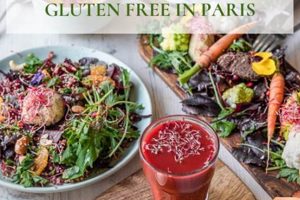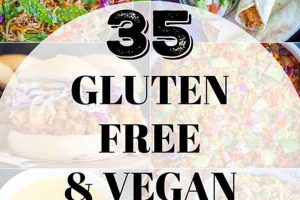A plant-based alternative to traditional pesto excludes both animal products and nuts. This pesto variation caters to individuals with dietary restrictions, allergies, or those adhering to a vegan lifestyle. Typical recipes replace pine nuts with ingredients such as sunflower seeds or hemp seeds, while nutritional yeast often substitutes parmesan cheese to provide a savory, umami flavor. Basil, garlic, olive oil, and lemon juice remain core components, ensuring a familiar pesto taste profile.
This adaptation broadens the accessibility of pesto, allowing individuals with nut allergies or dairy sensitivities to enjoy this classic sauce. It offers a comparable flavor profile to traditional pesto while accommodating specific dietary needs, thereby expanding culinary options. The development and increasing availability of these alternatives reflect a growing awareness of food allergies and dietary preferences within the consumer market. This product promotes inclusivity in shared meals and broadens the range of available ingredients.
Subsequent sections will delve into specific recipe variations, ingredient sourcing, potential health benefits, and its versatility in culinary applications. Discussions will also encompass storage recommendations and considerations for homemade versus commercially produced versions, providing a thorough overview for both consumers and culinary professionals.
Tips for Working with Vegan Nut-Free Pesto
The following recommendations aim to enhance the utilization and preservation of a specific pesto variation. Adherence to these guidelines promotes optimal flavor and product longevity.
Tip 1: Ingredient Quality Matters. Prioritize fresh basil, high-quality olive oil, and freshly squeezed lemon juice. The flavor of the final product is directly proportional to the quality of its components.
Tip 2: Sunflower Seed Preparation. Toasting sunflower seeds before processing enhances their flavor and adds a desirable textural element. Monitor the seeds closely during toasting to prevent burning.
Tip 3: Nutritional Yeast Application. Gradually incorporate nutritional yeast, tasting frequently, to achieve the desired cheesy flavor. Over-addition can result in a bitter taste.
Tip 4: Garlic Control. Garlic intensity varies. Begin with a smaller quantity and adjust to taste. Roasted garlic offers a milder, sweeter profile.
Tip 5: Proper Emulsification. Drizzle olive oil slowly into the food processor while it is running to ensure proper emulsification. This creates a smooth and creamy consistency.
Tip 6: Storage Considerations. Store pesto in an airtight container in the refrigerator for up to five days. Alternatively, freeze in ice cube trays for longer-term preservation; transfer the frozen cubes to a freezer bag for storage.
Tip 7: Preventing Oxidation. To minimize oxidation and maintain vibrant color, press a layer of olive oil onto the surface of the pesto before refrigerating. This creates a barrier against air exposure.
These tips facilitate consistent and high-quality preparation and preservation. Applying these techniques enhances the experience and ensures optimal utilization of this pesto variation.
The subsequent section will cover recipe variations and creative applications of this versatile culinary ingredient.
1. Ingredient Substitutions
Ingredient substitutions form the cornerstone of producing pesto that adheres to both vegan and nut-free dietary guidelines. This process involves replacing traditional components with alternatives that maintain the sauce’s characteristic flavor and texture while eliminating prohibited ingredients.
- Pine Nuts Replacement
Traditional pesto recipes feature pine nuts, which are problematic for individuals with nut allergies. Common substitutes include sunflower seeds, pumpkin seeds (pepitas), or hemp seeds. Each alternative imparts a subtly different flavor profile and texture to the pesto. Sunflower seeds, for instance, offer a mild, slightly nutty flavor when toasted, while hemp seeds contribute a creamier consistency due to their higher fat content.
- Parmesan Cheese Alternative
Parmesan cheese, a dairy product, is excluded from vegan diets. Nutritional yeast is frequently employed as a substitute. It provides a savory, umami flavor reminiscent of cheese due to its glutamic acid content. The quantity of nutritional yeast used directly influences the “cheesy” character of the final product, requiring careful adjustment to taste. Other alternatives include miso paste or a blend of ground cashews (when nut-free is not a concern) with seasonings.
- Oil Considerations
While olive oil typically remains a central ingredient, the specific type and quality can be varied. Robust extra virgin olive oil delivers a pronounced flavor, whereas a milder olive oil allows other ingredients, such as basil and garlic, to shine. Some recipes may incorporate small amounts of avocado oil or other neutral oils to adjust the texture or reduce the intensity of the olive oil flavor.
- Basil Augmentation
While basil is generally a mainstay, alternatives or complementary herbs can be introduced to diversify the flavor profile. Spinach, kale, or arugula can be blended with basil to add nutritional value and a subtle peppery or earthy note. Adjusting the ratio of basil to other greens is essential to maintain the characteristic pesto flavor.
The success of creating a palatable and authentic-tasting pesto hinges on the skillful selection and application of these ingredient substitutions. Understanding the flavor contributions and textural properties of each alternative is paramount in achieving a balanced and satisfying product that meets the specific dietary requirements of vegan and nut-free consumers. Careful consideration of these factors allows for the creation of a versatile sauce adaptable to various culinary applications.
2. Flavor Profile
The flavor profile of a specific pesto variant constitutes a critical determinant of its consumer appeal and culinary applications. This profile represents the composite sensory experience arising from the interplay of various ingredients. Understanding and manipulating this profile are essential for creating a desirable and versatile product.
- Basil Intensity and Freshness
Basil serves as the foundational flavor element. The intensity and freshness of the basil directly correlate with the overall quality. Optimal flavor necessitates the use of fresh basil leaves, preferably those harvested shortly before processing. Factors influencing basil’s flavor include variety, growing conditions, and storage methods. Substandard basil yields a pesto lacking in aromatic complexity and vibrant green color. The proportion of basil relative to other ingredients significantly influences the profile, dictating its herbaceous character.
- Nut Substitute Nuance
The selection of a nut substitute introduces a distinct flavor component. Sunflower seeds impart a subtly nutty and slightly bitter taste, which toasting can mitigate. Hemp seeds contribute a creamier texture and a more pronounced earthy flavor. Pumpkin seeds, while less common, offer a roasted, savory note. Each substitute alters the overall flavor profile, requiring careful consideration based on the desired outcome. The absence of pine nuts, traditionally present in pesto, necessitates strategic manipulation of other ingredients to compensate for the lost flavor notes.
- Umami Enhancement via Nutritional Yeast
Nutritional yeast provides the umami element traditionally derived from Parmesan cheese. The quantity of nutritional yeast added dictates the “cheesy” flavor intensity. Excessive amounts can result in an undesirable bitter taste. High-quality nutritional yeast contributes a savory, slightly nutty flavor. Alternative umami enhancers, such as miso paste or sun-dried tomatoes, may be incorporated to complement or supplement the nutritional yeast.
- Garlic Sharpness and Balance
Garlic imparts a pungent sharpness that requires careful balancing. Raw garlic delivers a more intense flavor, whereas roasted garlic offers a milder, sweeter alternative. The quantity of garlic must be adjusted to avoid overpowering other ingredients. Proper integration of garlic involves finely mincing or processing it to ensure even distribution throughout the pesto. Overpowering garlic masks the nuances of the other components, disrupting the overall flavor harmony.
The interplay of these factors defines the sensory attributes of the specified pesto variation. Mastering these individual elements is essential for formulating a balanced and appealing product. The skillful manipulation of these ingredients allows for the creation of a versatile pesto that meets the dietary restrictions of vegan and nut-free consumers while delivering a satisfying and authentic flavor experience.
3. Dietary Accommodation
Dietary accommodation, in the context of culinary arts, refers to the modification of recipes and food preparation methods to meet specific dietary needs, restrictions, or preferences. This is particularly relevant to the production and consumption of vegan and nut-free pesto, as it addresses the needs of individuals with allergies, intolerances, or ethical dietary choices.
- Nut Allergy Management
The absence of nuts is crucial for individuals with nut allergies, a potentially life-threatening condition. Traditional pesto recipes contain pine nuts, rendering them unsuitable for this population. Substituting ingredients like sunflower seeds or hemp seeds allows individuals with nut allergies to safely consume pesto without risking an allergic reaction. Rigorous sourcing and preparation protocols are necessary to prevent cross-contamination in commercial settings.
- Veganism and Animal Product Elimination
Veganism excludes all animal products, including dairy. Traditional pesto recipes contain Parmesan cheese. Nutritional yeast is commonly used as a substitute, providing a savory flavor profile that approximates cheese without violating vegan principles. This substitution expands the accessibility of pesto to individuals adhering to a vegan lifestyle, aligning with their ethical and dietary guidelines.
- Ingredient Intolerances and Sensitivities
Beyond strict allergies and veganism, individuals may have intolerances or sensitivities to specific ingredients. While basil, garlic, and olive oil are generally well-tolerated, adjustments may be necessary for those with sensitivities to these ingredients. For example, the quantity of garlic can be reduced, or a milder olive oil can be used. These adjustments enable a wider range of individuals to enjoy pesto without experiencing adverse reactions.
- Cultural and Religious Dietary Practices
Dietary accommodation also extends to cultural and religious practices. While pesto itself is not typically associated with specific religious dietary laws, its ingredients can be modified to align with certain observances. Ensuring that all ingredients are sourced in accordance with religious guidelines, such as kosher or halal certification, expands its appeal to diverse populations.
The careful consideration of dietary accommodations is paramount in creating a product that is both inclusive and safe. By addressing the needs of individuals with allergies, ethical dietary choices, and sensitivities, vegan and nut-free pesto broadens its market appeal and promotes culinary inclusivity. The successful implementation of these accommodations requires meticulous attention to ingredient selection, preparation methods, and labeling practices.
4. Culinary Versatility
Culinary versatility, referring to the adaptability of an ingredient or dish to diverse applications, constitutes a significant attribute of vegan nut-free pesto. The absence of animal products and nuts broadens its usability across various cuisines and dietary contexts. This adaptation allows for a wider range of individuals to incorporate the pesto into their meals, circumventing restrictions imposed by allergies or dietary preferences. The inherent flavor profile, easily modifiable through ingredient adjustments, further enhances its applicability.
The application of this pesto extends beyond traditional pasta sauces. It serves as a flavoring agent in vegan sandwiches and wraps, a marinade for tofu or vegetables, a component of plant-based dips and spreads, and a topping for pizzas. Examples include its use as a substitute for mayonnaise in vegan potato salad, as a spread on bruschetta with roasted tomatoes, or as a drizzle over grilled zucchini. These instances demonstrate the functional significance of its adaptable nature, allowing for creative culinary explorations that cater to diverse palates and dietary requirements.
In summary, the culinary versatility of vegan nut-free pesto stems from its inclusive ingredient composition and modifiable flavor profile. This characteristic enables its integration into a wide array of dishes and culinary traditions, enhancing its value as a staple ingredient for both home cooks and professional chefs. The challenges lie in maintaining flavor integrity across different applications and ensuring consistent quality through ingredient sourcing and preparation techniques.
5. Storage Stability
Storage stability constitutes a critical factor influencing the shelf life and overall quality of pesto variants. Unlike traditional pesto containing pine nuts and Parmesan cheese, formulations incorporating ingredient substitutions necessitate careful evaluation to ensure acceptable product longevity. The inherent properties of replacement ingredients, such as sunflower seeds and nutritional yeast, differ substantially from their conventional counterparts, potentially affecting degradation rates and susceptibility to spoilage. Factors such as oxidation, enzymatic activity, and microbial growth directly impact the shelf life and the maintenance of flavor and texture during storage. For instance, sunflower seeds, possessing a higher unsaturated fat content than pine nuts, are more prone to rancidity when exposed to air and light. Similarly, nutritional yeast, while contributing umami flavor, may exhibit altered behavior compared to Parmesan cheese in terms of moisture content and microbial susceptibility. Improper storage practices, including inadequate sealing or exposure to elevated temperatures, accelerate these degradation processes, leading to diminished product quality and reduced shelf life.
Strategies to enhance storage stability often involve modifications to the production process and packaging. Incorporating antioxidants, such as ascorbic acid (Vitamin C), can mitigate oxidative rancidity in sunflower seeds. Proper pasteurization or heat treatment reduces microbial load, extending shelf life under refrigerated conditions. Vacuum sealing or modified atmosphere packaging (MAP) minimizes oxygen exposure, further retarding oxidation and microbial growth. Formulating pesto with lower water activity can also inhibit microbial proliferation. In addition to these measures, consumer education regarding proper storage protocols is essential to maximize product longevity. Clear labeling instructions emphasizing refrigeration and appropriate sealing practices contribute to optimal preservation and maintain quality after opening.
In conclusion, storage stability is a primary consideration in the production and distribution of this pesto variation. The utilization of alternative ingredients necessitates a comprehensive assessment of potential degradation mechanisms and the implementation of appropriate preservation techniques. Effective storage protocols, combined with consumer awareness, are crucial for maintaining product quality, minimizing waste, and ensuring a safe and satisfying consumer experience. Continuous research and development efforts are imperative to identify innovative strategies for further enhancing storage stability and addressing the unique challenges associated with alternative pesto formulations.
6. Production Methods
Production methods significantly influence the quality, safety, and consistency of pesto variants. Careful attention to each stage of production is crucial to maintaining desired sensory characteristics and ensuring compliance with dietary restrictions. The selection and application of appropriate techniques directly affect the final product.
- Ingredient Sourcing and Handling
Sourcing involves selecting high-quality ingredients from reputable suppliers. For example, basil must be fresh and free from blemishes, while sunflower seeds should be recently harvested and properly stored to prevent rancidity. Handling protocols dictate appropriate sanitation procedures to minimize microbial contamination. These procedures often include washing and sanitizing equipment, implementing temperature controls during storage, and using dedicated utensils to prevent cross-contamination, particularly with nuts or dairy products that may be present in the same facility. The integrity of the supply chain is paramount in ensuring the purity and safety of the pesto.
- Processing Techniques and Equipment
Processing techniques encompass the specific methods used to combine and transform the ingredients. Food processors or blenders are commonly employed to achieve the desired texture. The sequence of ingredient addition and the duration of processing impact the final product’s consistency and flavor profile. For instance, adding olive oil gradually while the processor is running promotes emulsification and prevents separation. Equipment maintenance and sanitation are vital considerations to prevent contamination and ensure efficient operation. The type of equipment used can also influence the particle size and overall texture of the pesto.
- Quality Control Measures and Testing
Quality control measures are implemented throughout the production process to ensure adherence to established standards. These measures encompass visual inspections for color and texture, sensory evaluations for flavor and aroma, and analytical testing for parameters such as pH, moisture content, and microbial load. Allergen testing is particularly critical to verify the absence of nuts and dairy products. Documenting these measures provides a verifiable record of compliance with quality standards. Statistical process control can also be employed to monitor and optimize production parameters.
- Packaging and Preservation Methods
Packaging and preservation methods are implemented to extend shelf life and maintain product quality. Options include modified atmosphere packaging (MAP), vacuum sealing, and the addition of preservatives. The choice of packaging material impacts the product’s exposure to oxygen and light, which can contribute to oxidation. Pasteurization or high-pressure processing (HPP) can reduce microbial load and extend shelf life, but may also affect the flavor and texture of the pesto. Proper labeling clearly indicates storage instructions and allergen information.
These facets of production methods collectively determine the overall quality and safety of vegan nut-free pesto. Adherence to stringent protocols and continuous monitoring are crucial for delivering a consistent, allergen-free, and flavorful product to consumers. The success of this pesto hinges on a holistic approach to production, integrating each stage to achieve optimal results.
7. Allergen Control
Allergen control is paramount in the production of vegan nut-free pesto, directly impacting consumer safety and product integrity. This control necessitates strict protocols to prevent the introduction of unintended allergens, ensuring the product is safe for consumption by individuals with specific allergies.
- Ingredient Sourcing and Certification
Rigorous ingredient sourcing is the foundational element of allergen control. Suppliers must provide certifications guaranteeing the absence of specified allergens, particularly nuts and dairy, throughout their processing and handling procedures. Audits of supplier facilities should verify adherence to allergen control protocols. Documented chain-of-custody procedures are essential to track ingredients from origin to production, minimizing the risk of contamination. This includes verifying that seeds used as nut substitutes are processed in facilities free from nut contamination. Without this diligence, cross-contamination remains a significant risk.
- Dedicated Equipment and Production Lines
Employing dedicated equipment and production lines exclusively for vegan nut-free pesto minimizes the potential for cross-contact with allergens. This prevents shared equipment from transferring allergens to the pesto. Color-coded equipment and utensils can further reduce the risk of accidental contamination. Clean-in-place (CIP) systems should be implemented to thoroughly clean equipment between production runs, and validation studies should confirm the effectiveness of these cleaning procedures. Utilizing dedicated lines demonstrates a proactive commitment to allergen control.
- Employee Training and Hygiene Practices
Comprehensive employee training is vital for effective allergen control. Staff must be educated about allergen identification, cross-contamination prevention, and proper hygiene practices. Training programs should cover handwashing protocols, the use of dedicated protective clothing, and procedures for reporting potential allergen incidents. Regular refresher training ensures that employees remain vigilant about allergen control. Clear communication channels are essential to facilitate the prompt reporting of any potential contamination issues. Effective employee training fosters a culture of allergen awareness.
- Labeling and Consumer Communication
Accurate and transparent labeling is crucial for informing consumers about the allergen status of the product. Labels should clearly state that the pesto is “vegan” and “nut-free,” and should include a comprehensive list of ingredients. In some regions, precautionary allergen labeling (PAL), such as “may contain” statements, may be required to indicate potential cross-contamination risks despite control measures. Providing readily accessible information about allergen control practices on the company’s website or through customer service channels builds consumer trust and allows informed purchasing decisions. Clear and truthful labeling is fundamental to responsible allergen management.
These facets collectively underscore the significance of stringent allergen control measures in the production of safe and reliable vegan nut-free pesto. Thorough implementation of these protocols safeguards consumers with allergies and reinforces the product’s integrity in the marketplace. Continuous monitoring, validation, and improvement of allergen control practices are essential to maintain consumer confidence and prevent adverse reactions.
Frequently Asked Questions
The following section addresses common inquiries regarding a specific pesto variant, providing clear and concise information to enhance understanding and inform purchasing decisions.
Question 1: What ingredients are typically used in a vegan nut-free pesto?
A vegan nut-free pesto generally comprises fresh basil, garlic, olive oil, lemon juice, nutritional yeast, and a nut substitute such as sunflower seeds or hemp seeds. Specific recipes may vary based on desired flavor profiles and available ingredients.
Question 2: How does the flavor of vegan nut-free pesto compare to traditional pesto?
The flavor profile is comparable, though subtle differences exist due to ingredient substitutions. Sunflower seeds impart a mildly nutty flavor, while nutritional yeast provides an umami element similar to Parmesan cheese. Careful balancing of ingredients is crucial to replicate the authentic taste.
Question 3: How should vegan nut-free pesto be stored to maintain its quality?
The pesto should be stored in an airtight container in the refrigerator for up to five days. Covering the surface with a thin layer of olive oil helps prevent oxidation and preserve color. Freezing in ice cube trays is also a viable option for longer-term storage.
Question 4: Is vegan nut-free pesto suitable for individuals with severe nut allergies?
While formulated without nuts, individuals with severe nut allergies should exercise caution. It is essential to verify that all ingredients are sourced from nut-free facilities and that stringent allergen control measures are in place during production to prevent cross-contamination. Contacting the manufacturer for clarification is advisable.
Question 5: What are some common culinary applications of vegan nut-free pesto?
This pesto can be used as a pasta sauce, sandwich spread, marinade, dip, or pizza topping. Its versatility makes it suitable for a wide range of dishes, including vegan pasta salads, bruschetta, and grilled vegetable dishes.
Question 6: Can vegan nut-free pesto be made at home, or is it primarily available commercially?
This pesto can be prepared at home using readily available ingredients. Numerous recipes are accessible online and in cookbooks. It is also available commercially in various supermarkets and specialty food stores, providing a convenient alternative to homemade versions.
In summary, this specific pesto variation offers a palatable and accessible alternative to traditional pesto, catering to individuals with dietary restrictions while maintaining a comparable flavor profile. Careful consideration of ingredient sourcing, production methods, and storage practices is essential to ensure product quality and safety.
Subsequent content will explore recipe variations and advanced culinary applications, providing further insight into the versatility of this ingredient.
Conclusion
This exploration has detailed the nuances of vegan nut free pesto, emphasizing ingredient substitutions, flavor profiles, dietary accommodations, culinary versatility, storage stability, production methods, and allergen control. The necessity for rigorous sourcing, meticulous production techniques, and transparent labeling has been underscored, particularly concerning allergen management and the maintenance of product integrity.
As demand for inclusive food options continues to expand, the viability and safety of vegan nut free pesto will rely on consistent adherence to best practices and ongoing innovation in formulation and preservation. Further advancements in ingredient technology and processing methodologies offer the potential to enhance both the sensory attributes and the shelf life of this dietary-conscious alternative, fostering greater accessibility and consumer confidence.







